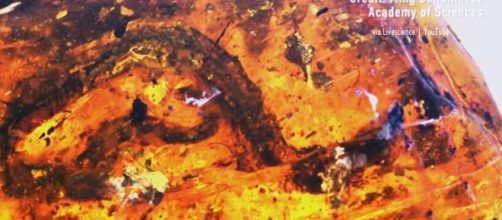A rare baby snake fossil, the oldest ever known, was found in one of two small pieces of amber in Myanmar, scientists revealed on Wednesday. This could likely be the oldest discovered fossilized snake as it lived in the "age of dinosaurs," Newsweek reported.
Scientists found small remains of a baby snake beautifully preserved in a" honey-colored" glassy substance which they determined was the first snake that lived in a forested environment. It was discovered in Myanmar, in Southeast Asia. It is an extraordinary find as it was the first baby snake found on record.
The new specimen is only about five centimeters long
The snake is so tiny that it just measures five centimeters. It is about 100 million years old. Scientists named the new species as Xiaophis myanmarensis. The reptile is believed to have lived in the late Cretaceous period. Scientists from the Chinese Academy of Sciences who participated in the discovery said that the finding provides insights into the evolution of the snakes at a time when reptiles shared the planet with the dinosaurs.
It is believed to be the first Mesozoic snake to have lived in a forested environment. The elder of the two fossilized snakes revealed about 97 vertebrae, including rib bones. Its anatomy is comparable in size to other living neonate snakes, Gizmodo noted.
Researchers say that this provides direct evidence that snake vertebral ontogeny has remained largely unchanged for the last hundred million years.
Similarities found to other Gondwana snakes
As the snake's skull was missing, researchers seemed to be slightly disappointed. But according to the report published by the journal, Science Advances, Scientists used X-ray studies and were able to determine major similarities to other Cretaceous snakes of the former continental block called Gondwana. This suggested a migration route of the block's fauna to Laurasia.
Researchers opined that this latest find would help them to study the manner in which snake offspring developed millions of years ago. This was particularly in terms of the formation of the joints that connect the spine and the closure of the tube that would become the spinal cord.
This particular species had become extinct, but studies have revealed that it might have survived in primitive form millions of years ago. Scientists now believe snakes were more ecologically diverse than previously thought as the fossils provide important insights into snake evolution, their development, and global distribution.


